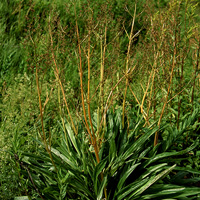Hairy Valerian
Scientific name: Valeriana edulis ssp. ciliata

Photo credit: Wasyl Bakowsky
Status
Threatened
Threatened
means the species lives in the wild in Ontario, is not endangered, but is likely to become endangered if steps are not taken to address factors threatening it.
Date added to the Species at Risk in Ontario List
January 26, 2022
Read the assessment report [PDF]
What it looks like
Hairy Valerian is an herbaceous, long-lived perennial native plant, often growing one metre in height or more. It flowers in May and June in southern Ontario and has tall stalks with small white flowers. It reproduces only by seeds, which are mainly wind dispersed. This plant has a large taproot that was a source of food and medicine for Indigenous peoples.
Where it lives
Hairy Valerian is typically found on wet and moderately wet prairies and fens, but it can also occur on drier sites such as hillsides and bluffs with groundwater flow. It occurs in full sun or light shade and is sometimes associated with calcium-rich sites.
Hairy Valerian can be found in the Great Lakes Region and occurs in a narrow band from Wisconsin and Iowa in the west, through Michigan and Indiana into Ohio.
Where it’s been found in Ontario
This plant is known to persist in three subpopulations in southwestern Ontario located in Brant and Huron counties. The viability of one of these subpopulations is questionable as only one plant has been observed recently at that location. About five subpopulations are believed to be extirpated including some in Middlesex and Waterloo.
What threatens it
Habitat loss due to the establishment of invasive species, such as Reed Canary Grass and Tartarian Honeysuckle, together with commercial and industrial development, are currently the most significant threats facing Hairy Valerian subpopulations in southern Ontario.
Action we are taking
This species and its habitat are protected under Ontario’s Endangered Species Act, 2007 (ESA).
The ESA also requires us to prepare recovery guidance for threatened species such as Hairy Valerian.
All species listed on the Species at Risk in Ontario List may be eligible for consideration for government funding through the Species at Risk Stewardship Program .
What you can do
Report a sighting
Submit your observations of species at risk to the Natural Heritage Information Centre (NHIC), which is Ontario’s conservation data centre. Join the (NHIC) Rare Species of Ontario" project in iNaturalist to make submitting your observations quick and easy.
Volunteer
Volunteer with species at risk programs, such as community science surveys, through your local nature club, a provincial park or other conservation organizations.
Be a good steward
Private landowners have a very important role to play in species recovery. If you find species at risk on your land, you may be eligible for stewardship programs that support the protection and recovery of species at risk and their habitats. Learn more about the Species at Risk Stewardship Program.
Invasive species seriously threaten many of Ontario’s species at risk. To learn what you can do to help reduce the threat of invasive species, visit:
- Invasive species in Ontario
- Ontario's Invading Species Awareness Program
- Ontario Invasive Plant Council
Report illegal activity
Report any illegal activity related to species at risk to